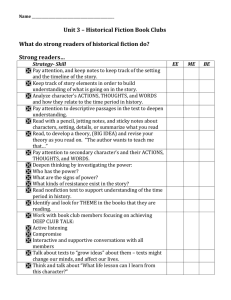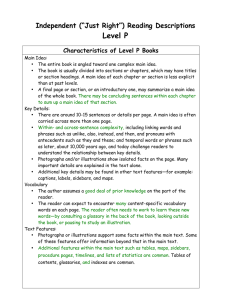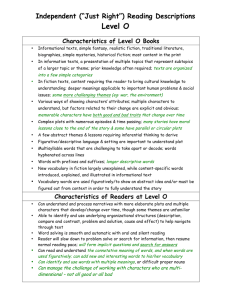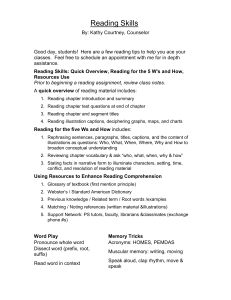Document 14340918
advertisement
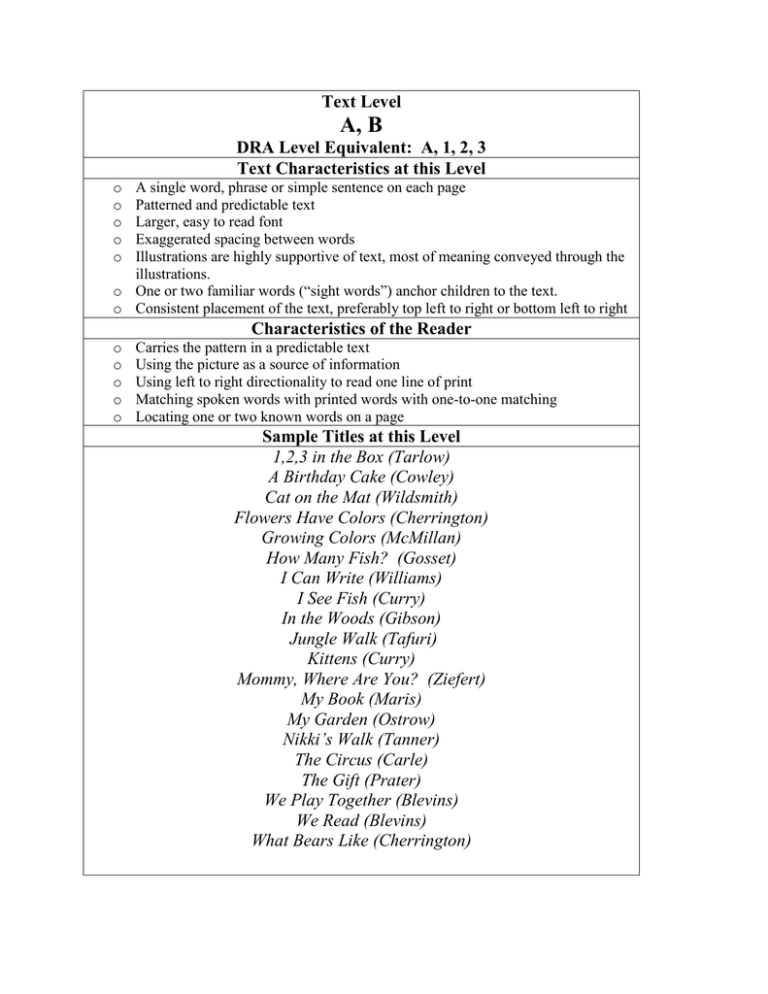
Text Level A, B DRA Level Equivalent: A, 1, 2, 3 Text Characteristics at this Level o o o o o A single word, phrase or simple sentence on each page Patterned and predictable text Larger, easy to read font Exaggerated spacing between words Illustrations are highly supportive of text, most of meaning conveyed through the illustrations. o One or two familiar words (“sight words”) anchor children to the text. o Consistent placement of the text, preferably top left to right or bottom left to right Characteristics of the Reader o o o o o Carries the pattern in a predictable text Using the picture as a source of information Using left to right directionality to read one line of print Matching spoken words with printed words with one-to-one matching Locating one or two known words on a page Sample Titles at this Level 1,2,3 in the Box (Tarlow) A Birthday Cake (Cowley) Cat on the Mat (Wildsmith) Flowers Have Colors (Cherrington) Growing Colors (McMillan) How Many Fish? (Gosset) I Can Write (Williams) I See Fish (Curry) In the Woods (Gibson) Jungle Walk (Tafuri) Kittens (Curry) Mommy, Where Are You? (Ziefert) My Book (Maris) My Garden (Ostrow) Nikki’s Walk (Tanner) The Circus (Carle) The Gift (Prater) We Play Together (Blevins) We Read (Blevins) What Bears Like (Cherrington) Text Level C, D DRA Level Equivalent: 4, 6 Text Characteristics at this Level o o o o o o o One to three short, simple sentences on each page Existence of slight pattern change at some point in the book Consistent placement of text with one or two minor changes Good spacing and larger font Highly support illustrations with few extraneous details A few high frequency words appear throughout the book Sentences are more varied, full range of punctuation o o o o Getting the mouth ready for the initial sound of a word Using left to right directionality and return sweep to next line of print Locating one or two known words on a page Monitoring for meaning, checking to make sure it makes sense Characteristics of the Reader Sample Titles at this Level A Cat’s Day (Twig) All Fall Down (Wildsmith) All Fall Down (Wildsmith) Biscuit Visits the Big City (Capucilli) Brown Bear, Brown Bear (Martin) Footprints in the Snow (Benjamin) I Went Walking (Williams) Kites (Ling) Little Sister (Mitchell) Mud (Lewison) Rain (Kalan) Rainbow of My Own (Freeman) Shoes (Winthrop) Sleepy Dog (Ziefert) Then and Now (Berger) Wake up! Wake up! (Wildsmith) What Time Is It? (Moriarty) What’s for Lunch? (Carle) Where’s Al? (Barton) Where’s The Fish (Gomi) Text Level D, E DRA Level Equivalent: 6, 8 Text Characteristics at this Level o o o o o More variation in the placement of text on the page Sentences are longer and more complex Readers must rely on graphophonics across the whole word Opening and closing sentences vary Moderate to high support from illustrations that contact details related to the meaning of the whole text o Some repetition of phrases, words or sentences. o Children will need to use sight words to help with unknown words, using parts of the familiar words as examples to help them unlock unfamiliar words. Characteristics of the Reader o o o o Rereading and self-correction behaviors common Reading with some fluency Cross checking one source of information against another Monitoring for meaning: checking to make sure what has been read makes sense and sounds right o Recognizes common chunks of words Sample Titles at this Level Bears in the Night (Berenstain) Beautiful Bugs (Fleming) Blue Bug Goes to School (Twig) Five Little Monkeys Jumping on the Bed (Christelow) Foot Book (Eastman) Footprints in the Snow (Benjamin) Fur (Mark) Go, Dog, Go (Eastman) Henry’s Busy Day (Campbell) It Looked Like Spilt Milk (Shaw) Mrs. Wishy Washy (Cowley) Mud (Lewison) Mud (Lewison) My Doll (Yukish) Shoes (Winthrop) Sleepy Dog (Ziefert) Taking Care of Rosie (Salem) Wake up! Wake up! (Wildsmith) What Time Is It? (Moriarty) Where’s Al? (Barton) Text Level F, G DRA Level Equivalent: 10, 12 Text Characteristics at this Level o o o o Text contains more challenging vocabulary Repetition of three or more phrases or sentence patterns throughout the book Illustrations provide moderate support Language structure and patterns may be more varied and complex; they may also contain more literacy “book language” o The content may often include a single character or story line throughout the book Characteristics of the Reader o o o o o o Rereading and self-correction behaviors common Reading with fluency Uses a repertoire of strategies to figure out words and phrases Cross-checking different cues (meaning, word structure, grammar) Can use known word parts to figure out unknown words Uses increasingly different chunks within words Sample Titles at this Level Amy Loves the Snow (Hoban) Are You There, Bear? (Maris) Biscuit (Capucilli) Biscuit Finds a Friend (Capucilli) Biscuit Wants to Play (Capucilli) Cookie’s Week (Ward) Does a Kangaroo Have a Mother, Too? (Carle) Each Pear, Each Plum (Ahlberg) Just for You (Mayer) More Spaghetti, I Say (Gelman) Not Me, Said the Monkey (West) Rosie’s Walk (Hutchins) SHHH (Henkes) Shoveling Snow (Cummings) Spot’s First Walk (Hill) The Carrot Seed (Krauss) The Teeny, Tiny Woman (O’Connor) Tiger is a Scaredy Cat (Phillips) Titch (Hutchins) What Daddies Do Best (Numeroff) Text Level H, I DRA Level Equivalent: 14, 16 Text Characteristics at this Level o Sentence Patterns are longer, varied and more complex o Greater use of literary or story language: Once upon a time…Long, long ago… o May include repeated pattern in cumulative form with more and more text added to each page o Low picture support o There will be more unfamiliar and often complex vocabulary Characteristics of the Reader o o o o Rereading and self-correcting regularly Reading with fluency Integrating a balance of sources of information Monitoring for meaning: checking to make sure what has been read makes sense and sounds right and what looks right o Demonstrate fluent phrasing of longer passages o Uses a repertoire of graphophonic (letter/sound) strategies to problem solve through text Sample Titles at this Level Albert the Albatross (Hoff) Are You My Mother (Eastman) Because a Little Bug Went Ka-choo (Stone) Big Dog, Little Dog (Eastman) Charlie Needs a Cloak (DePaola) Danny and the Dinosaur (Hoff) Father Bear Comes Home (Minarik) George Shrinks (Joyce) Goodnight Moon (Brown) Grizzwold (Hoff) Hattie and the Fox (Fox) Morris the Moose (Wiseman) Most Titles in the Little Critters Series (Mayer) Mrs. Brice’s Mice (Fox) Old Hat, New Hat (Berenstain) Ten, Nine, Eight (Bang) The Big Hungry Bear (Wood) The Very Busy Spider (Carle) We are Best Friends (Aliki) We’re Going on a Bear Hunt (Rosen) Text Level J, K DRA Level Equivalent: 18, 20 Text Characteristics at this Level o o o o o o o o o Longer, slightly more complex chapter books with more characters Most vocabulary words known by children through oral language or reading Variety in layout, reflecting different genres Wide range of high frequency words Some complex spelling patterns Variation in placement of subject, verb, adjectives, and adverbs Ample space between lines Sentences carrying over two to three lines and some over two pages Print and illustrations integrated in many texts Characteristics of the Reader o Use letter sound relationships in sequence to solve more complex words o Use known words to solve new words o Follow and remember a series of events over a longer text in order to understand the ending o Bring knowledge from personal experiences to the interpretation of characters and events. o Connect words that mean the same or almost the same to help in understanding o Read dialogue with phrasing and expression o Summarize a longer narrative text with multiple episodes. o Demonstrates fluent phrasing of longer passages Sample Titles at this Level Arthur the Moose Series (Hoban) Blackboard Bear (Alexander) Bony-Legs (Cole) Cat in the Hat (Suess) Cat in the Hat, Green Eggs, Hop on Pop (Suess) Commander Toad (Yolen) Farmer Boy Birthday, A (Wilder) Frog and Toad Series (Lobel) Froggy Learns to Swim (London) Harry Hates Shopping! (Armitage) Home in the Sky (Backer) Hooray for the Golly Sisters! (Byars) Hop on Pop (Suess) Jamaica Series (Havill) Little Bear Series (Minarik) Little Bill Series (Cosby) Mitchell is Moving (Cole) Nate the Great Series (Sharmat) Poppleton, Henry and Mudge Series (Rylant) There’s Something in My Attic (Mayer) Text Level L, M DRA Level Equivalent: 24, 28 Text Characteristics at this Level o o o o o o o o o Episodic and cumulative chapters Limited picture support Limited spacing Multiple story lines and characters More complex themes and characters to follow and develop Question in dialogue (fiction) and questions and answers (nonfiction) Words with a wide variety of very complex spelling patterns Complex plots with numerous episodes and time passing Variety in the layout of the print o o o o Solve content specific words, using graphics and definitions in the text Use chapter titles to foreshadow content Summarize a longer narrative, either orally or in writing Bring knowledge from personal experiences to the interpretation of characters and events Understand the relationship between the setting and the plot of a story Differentiate between what is known and new information Notice aspects of a writer’s style Infer the big ideas or message Characteristics of the Reader o o o o Sample Titles at this Level Amelia Bedelia Series (Parish) Arthur the Aardvark Series (Brown) Cam Jansen Series (Adler) George and Martha Series (Marshall) Horrible Harry Series (Kline) Jenny Archer Series (Conford) Junie B. Jones (Park) Look Who’s Playing First Base (Christopher) Magic Treehouse Series (Osbourne) Most books by Matt Christopher (sports themes) Pinky and Rex Series (Howe) Polk Street School Series (Giff) Russell Series (Hurwitz) The Littles Series (Petersen) Three Smart Pals (Rocklin) Tooter Pepperday (Spinelli) Zack Files Series (Greenburg) Text Level N, O DRA Level Equivalent: 30, 34 Text Characteristics at this Level o More complex sentence structure o New vocabulary in fiction texts largely unexplained o Complex spelling patterns complex plots with numerous episodes and time passing o Texts with multiple points of view revealed through characters behaviors o Use of words in italics, bold or all capitals to indicate emphasis, level of importance, or signal other meaning o Descriptive and figurative language that is important to understanding the plot o Black and white illustrations o Full range of punctuation o No or minimal illustrations Characteristics of the Reader o Begin to notice new and interesting words, and add them to speaking or writing vocabulary o Process a wide range of dialogue o Respond to plot tension or suspense by reading on to seek resolution o Read dialogue with phrasing and expression that reflects understanding of characters and events o Make connections between texts and other texts that have been read or heard o Demonstrate changing perspective as events in a story unfold o See changes in characters across time and articulate possible reasons for development o Demonstrate understanding of characters, using evidence to support statements Sample Titles at this Level A to Z Mysteries (Roy) Amber Brown Series (Danziger) Babysitters’ Club Series (Martin) Boxcar Children Series (Warner) Catwings Series (Le Guin) Chocolate Fever (Smith) Class Clown (Hurwitz) Enormous Crocodile, The (Dahl) Herbie Jones Series (Kline) Invisible Stanley (Brown) Julian and Huey Series (Cameron) Leftovers, The (Howard) Pony Pal Series (Betancourt) Ramona Series (Cleary) Text Level P, Q DRA Level Equivalent: 38, 40 Text Characteristics at this Level o Texts with deeper meanings applicable to important human problems and social issues o Characters revealed by what they say, think, and do and what others say or think about them o Descriptive language providing details important to understanding the plot o Settings distant in time and space from students’ experiences o Some words with connotative meaning that are essential to understanding the text o Full range of readers’ tools (table of contents, headings, call-outs, index, etc.) Characteristics of the Reader o Develop deeper understanding of words that have been encountered before but are not familiar o Form implicit questions and search for answers while reading o Summarize a text at intervals during the reading of a longer text o Demonstrate phrased, fluent oral reading o Justify predictions using evidence o Infer cause and effect in influencing characters’ feelings or underlying motives o Specify the nature of connections (topic, content, type of story, writer) o Adjust reading to process texts with difficult and complex layout Sample Titles at this Level American Girls Series (Most Titles) Anastasia Series (Lowry) Best Enemies (Leverich) Bunnicula (Howe) Encyclopedia Brown Series Hardy Boys Series (Dixon) If You Lived in the Time of…History series James and the Giant Peach (Dahl) Little House on the Prairie (Wilder) Magic School Bus Series Minpins, The (Dahl) Mr. Popper's Penguins (Atwater) Nancy Drew Series (Keene) Not-Just-Anybody Family, The (Byars) Sarah Morton’s Day (Waters) Stone Fox (Gardiner) The Dragonling (Koller) Understanding Book Characteristics Leveling is a complex process involving the examination of text features and the unique blend of these features in any one book. All features are important at all levels. Genre: The "genre" is the type of text and refers to a system by which fiction and nonfiction texts are classified. Each genre has characteristic features. Text Structure: The "structure" is the way the text is organized and presented. It may be narrative, as in most fiction and biographical texts. Factual texts are organized categorically or topically and may have sections with headings. Writers of factual texts use several underlying structural patterns to provide information to readers: enumeration, chronological sequence, compare/contrast, cause/effect, and problem/solution. The presence of these structures, especially in combination, can increase the challenge for readers. Content: The "content" refers to the subject matter of the text—the concepts that are important to understand. In fiction, content may be related to the setting or to the kinds of problems characters have. In factual texts, content refers to the topic of focus. Content is considered in relation to the prior experience of readers. Themes and Ideas: The "themes and ideas" are the big ideas that are communicated by the text. A text may have multiple themes or a main theme and several supporting themes or ideas. Sentence Complexity: Written language is qualitatively different from spoken language. Fiction writers use dialogue, figurative language, and other kinds of literary structures. Factual writers use description and technical language. In hybrid texts you may find a wide range of literary language. Vocabulary: "Vocabulary" refers to the meaning of the words and is part of our oral language. The more the words are accessible to readers in terms of meaning, the easier a text will be. The individuals, reading and writing vocabularies refer to words that they understand and can also read or write. Words: "Words" refer to recognizing and solving the printed words in the text. The challenge in a text partly depends on the number and the difficulty of the words that the reader must solve by recognizing them or decoding them. Having a great many of the same high frequency words makes a text more accessible to readers. Illustrations: The "illustrations" include drawings, paintings, or photographs that accompany the text and add meaning and enjoyment. In factual texts, illustrations also include graphics that provide a great deal of information that readers must integrate with the text. Illustrations are an integral part of a high quality text. Increasingly, fiction texts are including a range of graphics. Book and Print Features: The "book and print features" are the physical aspects of the text—what readers cope with in terms of length, size, and layout. Book and print features also include tools like the table of contents, glossary, pronunciation guides, indices, and sidebars. Reference: I.C. Fountas and G.S. Pinnell. 2005. Leveled Books, K-8: Matching Texts to Readers for Effective Teaching. Portsmouth, NH: Heinemann.

